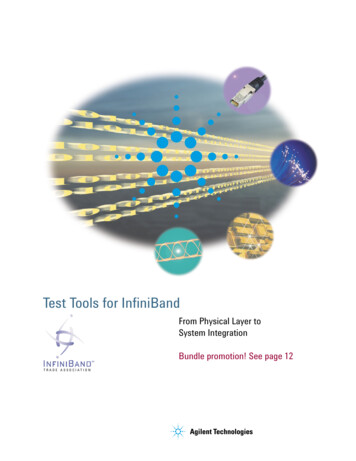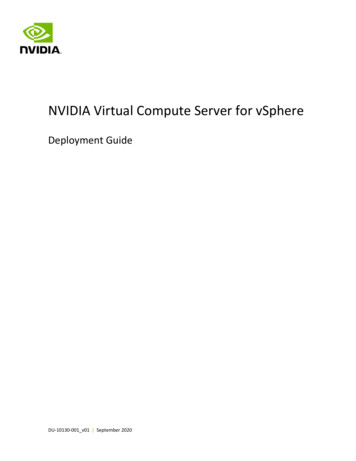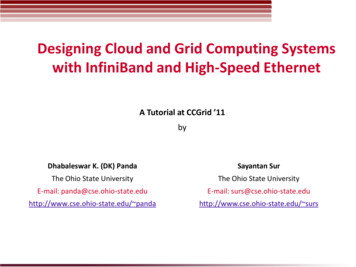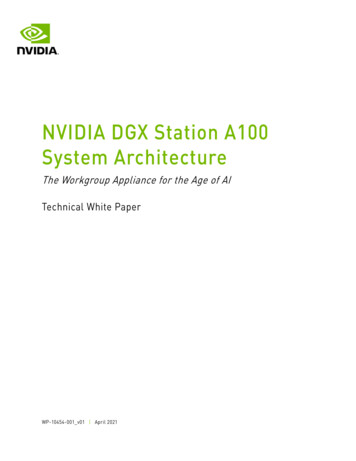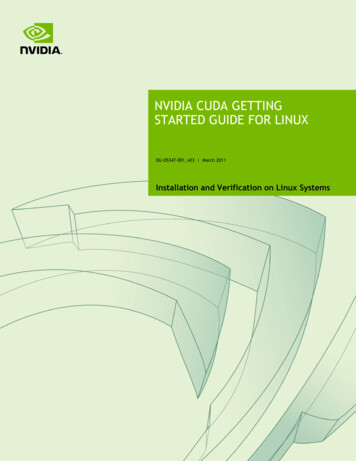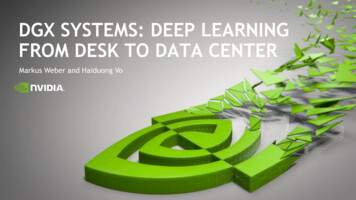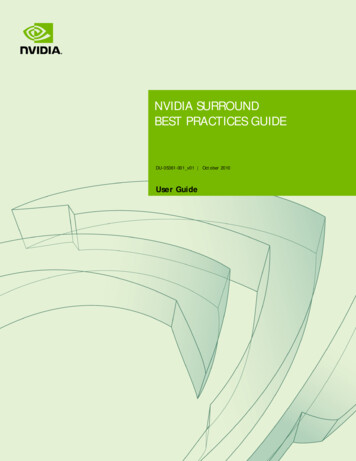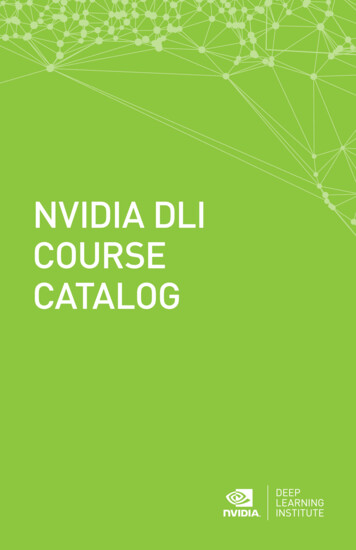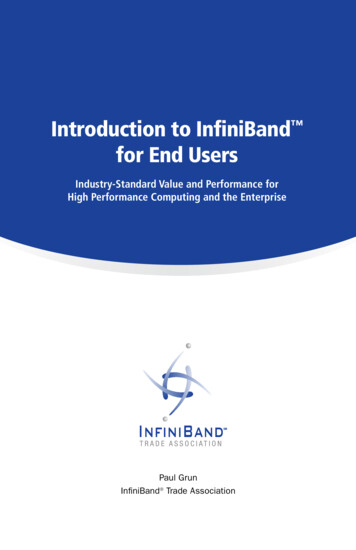
Transcription
InfiniBand ArchitectureTransforming I/O TechnologyAn IDC White PaperAnalysts: Jean S. Bozman and Vernon TurnerJanuary 2001InfiniBand Technology OverviewWhat is InfiniBand Architecture?InfiniBand architecture is a new I/O specification that will start to shipin a wide variety of server and interconnect products during 2001.InfiniBand architecture is a well-described technology with a final specification that was prepared by the InfiniBand Trade Association (IBTA)in the fall of 2000. More than 215 member companies participate inthe IBTA and will work together to see that InfiniBand architecture isestablished as an industry standard.InfiniBand architecture’s point-to-point linking technology will beused as the basis for an I/O “fabric” that will increase the aggregatedata rate between servers and storage devices. This capability will allowserver vendors to replace outmoded system buses and to multiply totalI/O traffic by a factor of two to four times or more compared withconventional system buses.More important, the I/O fabric of InfiniBand architecture will take on arole similar to that of the traditional, mainframe-based “channel architecture,” which used point-to-point cabling technology to maximizeoverall I/O throughput by handling multiple I/O streams simultaneously. That means that I/O need no longer be a bottleneck in improvingoverall data throughput for server systems.The Internet Will Drive InfiniBand Architecture AdoptionIDC believes that the Internet’s N-tier architectures are being drivenby the demands of Internet-driven data processing. By arranging manysmall servers in Web server farms or in clusters, IT managers have theability to add more servers as needed. This type of “pay-as-you-grow”build-out of computing infrastructure is necessary because userdemand for Internet data services ebbs and peaks unpredictably.One of the most significant obstacles to overcome in the “N-tier”architectures is that of interoperability created by multiple proprietaryarchitectures. By working from a universal standard, InfiniBand raises5 Speen Street Framingham, MA 01701 Phone (508) 872-8200 Fax (508) 935-4015
the potential of seamless connectivity across the server landscape, giving rise to improved service levels, product differentiation, andconsistent platform management.InfiniBand technology was designed to meet the emerging requirements of the Internet age in the following ways: It acknowledges that there are very fast processors capable of 1GHzor more, which will push more data than most conventional systembuses can handle. The result is a technology “mismatch” in whichthe fast processor has no way to push multiplying data packets tothese nearby growing storage resources. It will accommodate Internet data types, such as streaming video,multimedia, and high-resolution graphics, and will drive moredata traffic than traditional, business-oriented data processing. InfiniBand links, combined into an I/O fabric, will help toalleviate potential bottlenecks inside servers. InfiniBand architecture will improve link speeds between serversand storage, including storage area networks (SANs). InfiniBand architecture can be used as an interconnect technologythat will link individual servers into clusters for purposes of highavailability, scalability, and improved manageability.How InfiniBand Technology WorksInfiniBand technology works by connecting host-channel adapters(HCAs) to target channel adapters (TCAs). The HCAs tend to belocated near the servers’ CPUs and memory, while the TCAs tend tobe located near the systems’ storage and peripherals. A “switch” islocated between the HCAs and the TCAs, directing data “packets” tothe correct TCA destination based on information that is bundled intothe data packets themselves (see Figure 1).The glue between the HCA and TCA is the InfiniBand switch, whichallows the links to create a uniform fabric environment. One of thekey points of this switch is that it will allow packets of information (ordata) to be managed based on variables, such as service level agreements and a destination identifier.InfiniBand architecture has the potential to play a role in transformingor “morphing” computer architectures. Where once there were generalpurpose servers, including CPU memory and storage, there can bedensely packed application-specific servers or “blades” that can bechanged at will. At the same time, storage can be separated from theCopyright 2001 IDC. Reproduction without written permission is completely forbidden.External Publication of IDC Information and Data—Any IDC information that is to be used in advertising, press releases, or promotional materials requiresprior written approval from the appropriate IDC Vice President or Country Manager. A draft of the proposed document should accompany any suchrequest. IDC reserves the right to deny approval of external usage for any reason.InfiniBand Architecture:Transforming I/O Technology–2–AIDCPrinted onrecycledmaterials
Figure 1The InfiniBand Architecture ModelTargetCPUIB LinkMemCntirSysMemHCAIB LinkSwitchIB Link TCA TargetIB LinkCPUHost InterconnectTCARouterNetwork or IBRouterIB LinkSource: InfiniBand Trade AssociationCPU/memory components of these application-specific servers, andextremely large storage resources can be managed centrally by IT staffers.This transformation can be expected to start in server “farms” that areused as front-end tier 1 and tier 2 servers that handle Web serving andapplication serving (see Figure 2).Server vendors will be able to “pack” such servers closer together bymoving the I/O subsystems and storage and peripherals to a location“outside” the traditional server box. This will promote high-densityserver configurations in IT sites and in service provider (SP) data centers.The result could well be an evolution from today’s highly dense rackoptimized servers into a highly dense array of highly modular serverappliances or server blades. These blades will be designed for aparticular function, or solution, such as caching, email, security, orWeb serving. If a blade breaks or fails, it can be rapidly replaced, andworkloads can be routed around it until it is repaired.Flexible configurations of tier 1 and tier 2 servers, linked together(through an InfiniBand fabric) by InfiniBand links, will promote thereallocation of computing resources in fast-growing, Internet computing infrastructure. Further, InfiniBand links can be adapted by usingthree different link speeds. 1X, 4X, and 12X links are planned for shipment by system and interconnect vendors.Clustering of servers in all three tiers — tier 1’s Web servers, tier 2’sapplication servers, and tier 3’s database servers — can be enhanced byInfiniBand links. The InfiniBand architecture I/O fabric, made up ofAIDC–3–InfiniBand Architecture:Transforming I/O Technology
Figure 2N-Tier ArchitectureInternet/IntranetFR IO RU ET WE AR LLApplicationserver tierWeb servers/appliancesDatabaseserver tierSource: IDC and Dell, 2001multiple 1X, 4X, or 12X strands, can be used as a new high-speedinterconnect in clustered server configurations. These clusters can bedeployed in several ways: They can support high-availability failover,scalability of workloads, or improved manageability of multiple serversfrom a single console.Finally, scalable server systems will likely use InfiniBand links “inside”the server system itself. However, the design cycle for midrange andhigh-end server systems is several years. Very likely, InfiniBand architecture adoption will be widespread in entry servers, in clusters, and inconnections to SANs by the time that InfiniBand architecture is amajor building block for midrange symmetrical multiprocessing(SMP) and cc:NUMA server systems.InfiniBand Architecture Value PropositionWhy Consider Another Interconnect?IDC believes InfiniBand fabrics will coexist with a wide variety ofexisting I/O standards that are already widely deployed in user sites.Often, multiple architectures do and can exist together and help makeeach other better. Existing architectures include PCI, Ethernet, andFibre Channel. IDC also expects InfiniBand fabrics to coexist withfollow-on I/O standards, including PCI-X, Gbit Ethernet, and 10GbitEthernet. Yet, InfiniBand architecture offers a new approach to I/Oefficiency by replacing the traditional system bus with an I/O fabricthat supports parallel data transfers along multiple I/O links.InfiniBand Architecture:Transforming I/O Technology–4–AIDC
However, the aspects of InfiniBand architecture that will likely causemigration away from these well-established I/O standards are thefollowing: InfiniBand architecture offloads CPU cycles for I/O processing, it delivers faster memory pipes and higher aggregate data-transferrates, and the InfiniBand fabric will reduce management overhead forthe server system.Unmet Needs that InfiniBand Architecture AddressesIn 2000, the server market saw the explosive introduction of applianceservers and rack-optimized servers into the entry server market (serverscosting less than 100,000). Many of the general-purpose servers andpedestal-based servers were being placed into racks in every newInternet data center. Earlier we discussed this phenomenon as part ofthe modularization of the data center. However, as we migrate tosmaller and denser servers (1U form factor or smaller), real estate issueson the server motherboard, heat and power dissipation, and consumption combined with sheer connectivity may inhibit the potential of theblade technology. InfiniBand fabrics have the potential to address all ofthese needs in a simple manner.InfiniBand Architecture’s Performance CharacteristicsInfiniBand architecture’s role will depend largely on the workload that itsserver, storage, and network are attempting to support. For example, ifthe server is simply a front-end device, a Web hosting server, or fileand print appliance, then the 1X link should be sufficient to provideboth throughput and connectivity. Most of the Internet tier 1 serverplatforms would be met by this link.The 4X link may manifest itself in the tier 2 environment. Here serversare likely to be mainly 2-way and 4-way processors that need to runlarger workloads where some latency issues can be tolerated. However,many of these workloads begin to take on mission-critical,service-level characteristics.Finally, the 12X link could be used for transaction processing and database management, where almost no latency is tolerated as features suchas two-phase commits are made to keep the data up-to-date. Given theseworkload characteristics, the 12X links would appear in the higher endof the tier 2 and tier 3 server architectures.In addition, IDC believes that any data-intensive or heavy transactionprocessing that is performed outside the bounds of a local data centerenvironment would be ideal candidates for the 12X links. The additionalbandwidth and I/O aggregation could be handled by this topend switch.Cost ImplicationsThe impact on the cost of interconnect technology may be significant.As with any technology that becomes a standard and ultimately obtainsAIDC–5–InfiniBand Architecture:Transforming I/O Technology
a ubiquitous role in the market place, InfiniBand architecture probablywill drive down the costs of server interconnect, bridges, and switches.IDC believes that vendors that can balance this decline with added valuein their products (such as higher-availability solutions, software, andmanagement stacks) will maintain or increase their current margins.However, it is clear by the number of new and emerging InfiniBandcompanies that the overall cost of the server technology will continueto decline. IDC can cite previous examples within the server industrywhere technology disruptions created better value for the consumer(e.g., mainframe technology moving from water-cooled bipolar technology to air-cooled CMOS chipsets).Market Status and Potential: An Adoption PlanIDC’s InfiniBand Architecture Server ForecastIDC has attempted to size the server market opportunity for InfiniBandarchitecture (see Table 1). In doing so, it evaluated the greatest segments of the server market where InfiniBand can be more readilydeployed. It has identified that the entry server market (whichaccounts for more than 90% of all server unit shipments) as beingmost acceptable to InfiniBand technology. It further constrained thisforecast by advising the reader that IDC’s appliance server forecast isnot integrated into this existing forecast. (Note: IDC forecasts that in2004, the appliance server market may exceed 2 million additionalunits, or approximately 22% of the server market).Table 1Worldwide InfiniBand-Capable Servers Forecast (2000–2004)Price Band20002001200220032004 10K039,744706,7531,651,3693,972,127 10–24.9K04,362129,848290,189668,548 25–49.9K049323,54572,144162,015 ,042,5534,871,604Key Assumptions:Appliance server market is not included in the analysis.IA32, IA64, RISC, and CISC chip architectures are included.Messages in the Data:The greatest InfiniBand architecture opportunity lies in the 10K server market.The greatest InfiniBand architecture opportunity lies with IA32-based servers.Source: IDC, 2001InfiniBand Architecture:Transforming I/O Technology–6–AIDC
InfiniBand Architecture and the General-Purpose Entry Server MarketThe InfiniBand architecture market is based on workload requirementsrunning on matching server configurations. IDC’s InfiniBand serverforecast was developed using a constrained model and, as a result, maybe viewed as being conservative. IDC used the entry server market asInfiniBand’s starting ground because it is made up of more than 90%of all server units. In doing so, the forecast was able to identify theserver market capable of supporting InfiniBand architecture with minimal disruption to existing infrastructure because these servers have ahigh turnover and are widely accepted in new environments wherelegacy infrastructures do not exist.InfiniBand Architecture and the Appliance Server MarketToday’s all-in-one entry servers are being complemented by a newcategory of appliance servers that typically support specific workloadsand that typically arrive on the customer site with preconfigured, preinstalled, system and application software. This development promotesrapid deployment of workload-specific servers. At the same time, itanswers the industry shortage of highly skilled IT professionalsand system administrators who are capable of reconfiguring generalpurpose servers. IDC research shows that the appliance server market isgrowing from 740 million in 1999 to more than 11 billion in 2004.These appliance servers typically cost little, have very specific workloadfunctions, and, therefore, performance requirements are easily measured.In addition, the appliance servers are being readily accepted in newdata center environments, where existing fabric infrastructures havenot been established. If those fabrics are not in place, then InfiniBandarchitecture adoption will take place more slowly. Once those fabricsare installed, however, the IT site or SP data center will be able toachieve the following benefits: faster reallocation of server resources, simplified clustering, and better links between servers and storage systems.IDC believes that workloads will determine the type of server technologyto be used. In doing so, the workload environment could determinethe success of the InfiniBand fabric. For example, a complex, highlyscaled, rack-optimized server environment within a traditional enterprise or service provider offers a great opportunity for InfiniBand fabric management. Here, InfiniBand’s fabric management tools willencourage the use of 4X or 12X InfiniBand fabrics in arrays of computersthat are being linked in order to tackle ecommerce applications that “tap”the compute power of many individual servers. User requests, for example, could enter the server array via the tier 1 servers, which are cooperating through the use of workload-balancing software and then be passedon to a cluster of servers running a particular application or database.Thus, user requests are navigating through the multiple tiers of computers connected via InfiniBand fabric, which function as a single computing resource from the end users’ perspective.AIDC–7–InfiniBand Architecture:Transforming I/O Technology
InfiniBand Architecture and the RISC Server MarketIDC believes that vendors of RISC servers, including Unix/RISCservers, the IBM AS/400, and RISC-based proprietary midrange servers,will adopt architecture components more slowly than vendors of entrybased systems. One reason for this is that RISC systems typically useASIC-controlled I/O subsystems, in which single-vendor technology hasbeen “burned into” silicon. There would be little advantage of usingInfiniBand architecture to completely replace these ASIC-based I/Osubsystems, which generally perform well and were developed with largeR&D investments by the vendors themselves.However, over time, today’s RISC-based systems will likely incorporateInfiniBand technology in some way. They may incorporate “bridge”chip technology to tie InfiniBand architecture-based I/O subsystemsto the current RISC server I/O interconnects. In some cases, the RISCservers may be evolving to incorporate IA64 microprocessors, such asthose in the SGI Origin series and in the HP N-Class and Superdomeseries. In those cases, InfiniBand architecture will be used as an I/Osubsystem of choice to support I/O from IA64 motherboards to outboard storage resources.RISC-based entry servers will likely support InfiniBand architecturebefore midrange and high-end RISC servers support it. Such entryservers are already becoming a staple of SP data centers, known fortheir high performance and combat-proven RAS characteristics. IDCbelieves InfiniBand links could link multiple RISC-based entry serverstogether into clusters or into Web server farms.InfiniBand Technology and Productization RoadmapIDC believes that InfiniBand architecture will be phased in over aperiod of several years. However, its adoption will likely be somewhatmore rapid in SP environments than in IT environments, which haveconsiderable investments in legacy computing architectures, includingtraditional forms of I/O.IDC believes InfiniBand architecture will likely coexist with a widevariety of existing I/O standards that are already widely deployed inuser sites. Among these are PCI, Ethernet, and Fibre Channel. IDCalso expects InfiniBand architecture to coexist with follow-on I/Ostandards, including PCI-X, Gbit Ethernet, and 10Gbit Ethernet. Yet,the InfiniBand architecture offers a new approach to I/O efficiency byreplacing the traditional system bus with an I/O fabric that supportsparallel data transfers along multiple I/O links.IT “Conservatism” Will Phase in InfiniBand AdoptionIT managers are, by nature, conservative about making sudden changesin their production computing environments. PCI, for example, iswidely installed, having been shipped in production servers since themid-1990s. For that reason, it is likely that PCI-X is likely to do wellInfiniBand Architecture:Transforming I/O Technology–8–AIDC
as a replacement/upgrade from PCI. Fibre Channel has a large installedbase in the storage arena, in SANs, in clustering of data center servers,and in the WAN-connected, geographically dispersed data centers.In IT organizations, InfiniBand architecture will be introduced into anenvironment that is already rich with a variety of I/O technologies.Introduction of InfiniBand architecture will likely take place in thosesystems that will benefit most — arrays of front-end Web servers andclusters of servers linked to massive amounts of external storage. Theseelements of the computing infrastructure are the ones that will show themost improvement from the use of a switched fabric for I/O thatsupports multiple I/O links, working in parallel, to shuttle large packetsof data between server engines and system peripherals.With the development of InfiniBand-Fibre Channel and InfiniBandGbit Ethernet routers, switches, and adapters, InfiniBand architecturebased servers can be deployed alongside existing servers and plugged intothe existing infrastructure.Service Provider Adoption is Expected to AccelerateInfiniBand architecture is likely to have a strong appeal for clustering,for service providers’ N-tier networks and for a new generation ofInternet-enabled systems for IT data centers. The SP play is a strongone, both for reasons of SPs’ openness to modular computer design(dense packing) and their heavy use of clustering (Web clustering orapplication clustering, or both).Service provider sites are best positioned to adopt InfiniBand architecturequickly because they have little, if any, legacy computing architecture.These sites are growing rapidly, adding dozens of servers each fiscalquarter. A rapid improvement in I/O between servers and storageresources can only help SPs provide more efficient data services to theirend customers.Bridge Technologies: The First Wave of InfiniBand ArchitectureAdoptionIDC research has shown that a number of vendors are prepared to shipsuch bridge technologies, whether at the HCA, TCA, or switch layersof the InfiniBand architecture. This means that IT managers and SPtechnologists will have a variety of choices in terms of the ways theycan tie in InfiniBand-enabled servers to the already-installed serversthat were shipped with PCI or Ethernet I/O links, for example.The advantage of a bridge I/O technology is that it can be immediatelyadopted on a variety of already-installed server machines. That is, serverswith PCI slots or those with fast Ethernet links are already widely usedand can become InfiniBand-enabled as soon as the bridging chips shipto customers.AIDC–9–InfiniBand Architecture:Transforming I/O Technology
Further, the “bridge chip” technology allows systems vendors to sellservers with several options for I/O ports. This allows vendors to protecttheir investments in previous I/O technologies, and it allows customersto move to InfiniBand architecture when they are ready to do so.Clustering: The Next FrontierClustering is the next frontier for InfiniBand architecture adoptionbecause InfiniBand links can be “retro-fitted” onto existing serversystems to create an industry-standard cluster. InfiniBand architecturecould provide high-speed links between multiple servers, boostingtotal aggregate data bandwidth and minimizing the time for failover ofapplications and databases from one server to another.I/O has long been a gating factor in achieving seamless clusteringcapability. IDC research shows that a wide variety of interconnectlinks are used to achieve clustering today: Ethernet (10Mbps), fastEthernet (100MBps), 1Gbit Ethernet, SCI, and Fibre Channel amongthem. The introduction of InfiniBand fabrics will provide multiple“strands” of I/O between servers. This should help to boost throughput and to reduce latency between the clustered servers.However, InfiniBand technology will likely compete with two otherfast interconnect technologies — PCI-X and 10Gbit Ethernet. It islikely that several interconnect standards will remain in the marketplace, rather than that one will dominate others. Server environmenttends to add new servers and new technologies, rather than to discardthe older technologies. Thus, the product “mix” evolves over time,with newer server platforms gradually replacing the older ones.Finally, clustering technology involves a mix of hardware, software,and interconnects. All three elements must be in place in order toforge strong links between individual server nodes. Thus, the needfor InfiniBand-enabled software cannot be overlooked: The time toadoption with respect to clustering can be minimized through theshipment of IB-enabled components and IB-enabled software.Scalable Servers: The Final FrontierThe final stage of the adoption curve, at which InfiniBand architecturehas been incorporated into all sizes of servers, is adoption of InfiniBandarchitecture in future scalable servers and cc:NUMA server designs.The long planning and design cycles inherent in such advancedcomputer architectures dictates a slow adoption cycle. Thus, SGI hassaid that it plans to incorporate InfiniBand architecture into the nextgeneration of Origin 3000s that are expected to ship sometime in thenext two years.InfiniBand links are for I/O only — they will not replace internalcache-coherent interconnects between multiple processor boards.Nonetheless, it will take some time for individual server vendors toInfiniBand Architecture:Transforming I/O Technology– 10 –AIDC
phase out the embedded, proprietary I/O links in scalable midrangeservers and in high-end servers, in favor of industry-standard InfiniBandtechnology. Systems vendors have invested many years of time andmoney in developing these I/O links, and it will likely take some timeto redesign systems to the brand-new InfiniBand specification, finalized in the fall of 2000.The User Equation: IT Sites and SP Data CentersIDC has long believed that customers are more concerned about anapplication’s performance, or its workload characteristics, than they areabout the hardware it is running on. This has been seen clearly in theexplosion of rack-optimized servers configured for specific tasksduring 2000. Workloads such as email have moved from their role. Forexample, email, once a communications vehicle that linked PCsscattered across a corporation, has evolved into a mission-critical application running on a single-functioned server, or array of servers. Thus,the characteristics of performance, scalability, and recovery all playincreasingly important roles for IT management.Today’s infrastructure models embrace hundreds or even thousands ofservers in a multi-tiered computing infrastructure, requiring an extremely dense computing power and cabling and enhanced remote management of these server assets. Further, traditional IT organizations havedeveloped sophisticated remote management and recovery practices thatare now being adopted by the new, large SPs, as they “build out” theirInternet computer infrastructure. Attempts to replicate this model havebeen somewhat bumpy, something that is borne out by operationalproblems with fast-growing computer systems and high-risk serverconfigurations that tend to fail in spectacularly noticeable ways thatdraw media attention. IDC notes that InfiniBand architecture, with itspotential to simplify the server configuration while increasing its reliability, availability, and serviceability (RAS), provides the opportunityfor IT managers to significantly lower IT management costs and toimprove service levels to end customers.ChallengesThere are significant challenges to InfiniBand architecture from bothexisting server vendors and their own customers. Given that there havebeen several I/O standards already under way, many vendors may nothave the financial ability or the research capacity to invest in anotherI/O fabric. Instead, they may want to or need to harvest the investment already made. Likewise, many end users may not want to riskinstalling another I/O fabric within their data centers.In addition, the introduction of a “standard” implies that interoperability issues take a back seat. This may be true only after significantcooperation between many of the standard’s participants occurs.Historically, the interoperability wild card has inhibited adoption rates.Everyone from the hardware and software vendors to the data centerAIDC– 11 –InfiniBand Architecture:Transforming I/O Technology
operations staff have struggled to make a seamless processing from disjointed offerings.Finally, InfiniBand architecture may have the ability to level the playingfield across different operating systems and therefore challengeserver vendors to provide additional value through applicationsoftware and middleware. As a result, InfiniBand architecture may beperceived as a threat to weaker server vendors that may not have strongsoftware portfolios.All of these challenges are justified, but InfiniBand architecture can beused to help vendors provide their customers with the best I/O fabricchoices that their workloads are demanding. InfiniBand architectureshould be viewed as complementary to any of the standards and evolutionary to new server farms of the future.SummaryIn the years since the desktop personal computer was elevated to thePC server platform, nearly every element of the server infrastructurehas been upgraded and improved. However, the I/O bus that providesconnectivity and bandwidth between the server and the storage deviceshas not kept pace with the speed-up in nearly all of the componentssurrounding it — the microprocessor, memory, and storage.Because bandwidth, storage, and network capacities are going tocontinue to put demands on the server to deliver more content fasterand in a sustained manner, IDC believes that InfiniBand architectureis an enabling technology. It will complement the existing I/O deliveryvehicles, and it will allow them to better support the growing demandsof Internet-computing workloads. IDC believes Internet data requirements will continue to grow as long as the economic model ofimproved speed and lower costs continue. It is imperative for servervendors to establish a server platform that meets this challenge.The advantages of a point-to-point, high-speed, switch fabric interconnect architecture are seen every day with existing mainframe-classservers. IDC believes that applying this principle of an I/O fabric thatcan replace the aging system-bus technology will allow growth opportunities for all computer-technology vendors.InfiniBand Architecture:Transforming I/O Technology– 12 –AIDC
NORTH AMERICAIDC MalaysiaIDC Hungary5 Speen StreetFramingham, MA 01701508-872-8200Suite 13-03, Level 13, Wisma KiaPengNo. 3, Jalan Kia Peng50450 Kuala
(e.g., mainframe technology moving from water-cooled bipolar tech-nology to air-cooled CMOS chipsets). Market Status and Potential: An Adoption Plan IDC's InfiniBand Architecture Server Forecast IDC has attempted to size the server market opportunity for InfiniBand architecture (see Table 1). In doing so, it evaluated the greatest seg-
